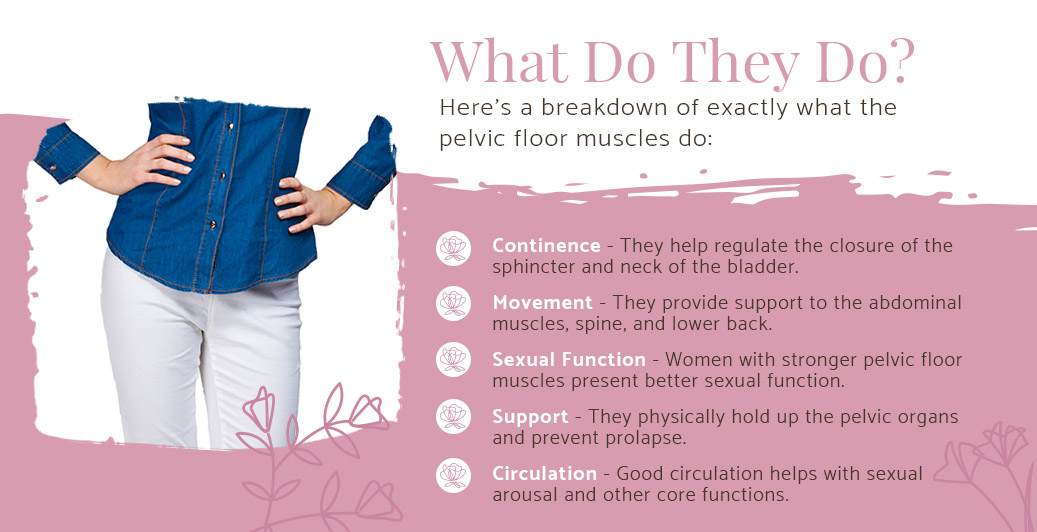
All About Pelvic Floor Exercises for Urinary Incontinence

When we think about the complex systems that make the digestive and urinary tracts work like they should, we rarely think about muscles. We blame leakage and dysfunction on an overactive bladder or grumpy bowels. But the truth is that the muscles play a massive role in continence. Strengthening them can do wonders for urinary incontinence (UI) and lead to a host of other positive outcomes, from preventing injury to enhancing sexual arousal.
In addition to pairing you with the best incontinence products, Sofia & Grace is here to empower you to attack UI head-on. Understanding the role of the pelvic floor muscles is a great way to arm yourself with the knowledge you need to stop incontinence from getting in your way.
What Is the Pelvic Floor?
The pelvic floor is made up of a sling of hammock-like muscles that line the bottom of the pelvis. They stretch from the pubic bone to the tailbone and run the width of the bottom of the pelvis. The muscles and connective tissues that comprise the pelvic floor hold up the pelvic organs—including the bladder, uterus, and bowels—and scaffold them against gravity. At the same time, they provide strength and stability to support movement, sexual function, and more.

Here’s a breakdown of exactly what the pelvic floor muscles do:
- Continence. The most common effect weakened pelvic floor muscles have is contributing to bowel and urinary incontinence. That’s because these muscles help regulate the closure of the sphincter and neck of the bladder, helping you control when you go. Dysfunction in these muscles can cause lack of control, but also a lack of coordination. This can lead to pelvic floor dyssynergia, a condition which makes it difficult to have a bowel movement.
- Movement. All muscles in the body work together to support one another, and when one weakens, the rest are likely to follow suit. The pelvic floor muscles help the body achieve pelvic stabilization while also providing support to the abdominal muscles, spine, and lower back. Strength in core, back, and legs is needed to safely move and exercise without injury.
- Sexual Function. The pelvic floor muscles play a key role in the sexual function of men and women. Without them, we wouldn’t be able to achieve orgasm or erection. Research shows that women with stronger pelvic floor muscles present better sexual function, in part because these muscles react to sexual stimuli with increased blood circulation and involuntary contractions during orgasm. Women with a stronger pelvic floor are also able to relax their muscles more, helping the vagina to open up and increase pleasure.
- Support. The pelvic muscles play an important role in physically holding up the pelvic organs and preventing prolapse—a condition which occurs when the uterus, bladder, or bowels drop down into the vagina. This leads to a feeling of heaviness, discomfort, and pain in the pelvic area. Prolapse is common after pregnancy and childbirth as well as during menopause.
- Circulation. The body relies on good circulation for sexual arousal and other core functions. Having weak pelvic floor muscles often renders them inactive or atrophied, which prevents blood from properly circulating to the places where they’re needed the most. Doing regular pelvic floor exercises can help boost circulation and lead to enhanced sexual arousal.
Incontinence and the Pelvic Floor
If you’ve been asking yourself: Why do I pee so much? Or you have noticed that you’re experiencing leaks while running, coughing, sneezing, exercising, lifting or laughing, you may be experiencing incontinence as a result of a weak pelvic floor. But why does this happen?

Much of your urinary tract is dictated by the nervous system. When you have to pee, the nervous system sends a feeling of urgency to the bladder, which tells your pelvic floor muscles and sphincter to relax, allowing you to empty your bladder or bowels. When you run, cough, sneeze, or lift something heavy, your body puts pressure on the bladder—that same feeling of urgency—which kicks it into motion.
In people who have strong pelvic floor muscles, the urge is no problem because they are able to voluntarily tighten, squeeze, and relax them as needed. Strong pelvic floor muscles allow for better control of the opening to the bladder. When they begin to weaken, you lose the ability to stop the flow when you get that urge. Better control of the pelvic floor can help you control these urges without actually emptying the bladder.
Why the Pelvic Floor Weakens
With incontinence being so prevalent among women, it probably won’t surprise you to learn that many female reproductive functions—pregnancy, childbirth, and menopause—contribute to weak pelvic floor muscles. During pregnancy, a hormone called relaxin is produced by the ovary to help relax and stretch these muscles to make childbirth easier. If stretched too much during childbirth, permanent damage to the pelvic floor muscles and ligaments is possible.
During menopause, estrogen levels drop. This can cause a host of issues for muscles throughout the body because estrogen helps keep ligaments strong and elastic. When your body’s estrogen starts to level off—a natural part of menopause and aging—the pelvic floor muscles get less support and become weaker and thinner. For this reason, low-dose, topical estrogen, which can help rejuvenate the vagina and urinary tract, is becoming a popular treatment for incontinence.

But that’s not to say that men or women who haven’t experienced any of the above conditions automatically have strong, resilient pelvic floor muscles. Various other issues and health concerns can lead to a permanently weakened pelvic floor, including prostate cancer, chronic constipation, chronic cough, smoking, and excess weight.
How to Do Pelvic Floor Exercises
No matter if you’re experiencing postpartum incontinence or are approaching menopause, strengthening the pelvic floor muscles is important to your overall health and well-being. To do that, you need to identify them within your body and get comfortable with Kegels. These are exercises that zero-in on the pelvic floor muscles to help you better control the flow of urine.
There are many ways you can do Kegels at home, from lying in bed to practicing simple exercise routines with your yoga mat. If you find that doing these exercises on your own is too challenging, you may consider pelvic floor physical therapy. This kind of physical therapy involves seeing a specialist who will design a program just for you, using stretching and exercises to strengthen weak pelvic muscles.
Kegels: The Key to a Stronger Pelvic Floor
Kegel exercises—named after the gynecologist Arnold Kegel, who published information about these movements in the 1940s—are any exercises that work the pelvic floor muscles. Simply put, they involve contracting and relaxing the muscles, helping to strengthen them and train you to control them as needed.

How to Find Your Pelvic Floor Muscles to Do Kegels
Before you learn how to do Kegels, you’ll want to work on identifying the pelvic floor muscles. Though they’re responsible for many key functions, they’re not seen or easily felt, so finding them can be a challenge if you aren’t used to it.
To find your pelvic floor muscles, pretend that you’re peeing but want to stop the stream of urine. Contract the muscles you would use to do so. If this feels too hard, try it while you’re actually peeing. But don’t actually stop the stream if your bladder is full, as this can contribute to weakened muscles and can even lead to a urinary tract infection (UTI). The muscles that you use to stop the flow of urine are the muscles you want to strengthen with Kegels.
How to Do Kegels
To do Kegels, you want to make sure you’re in a comfortable environment with few distractions so you can focus on relaxing the rest of your body. Start in a lying position with your knees bent. While focusing on your breath, squeeze and draw in the muscles as if you’re trying to stop the flow of urine. Avoid clenching your butt or surrounding muscles. Squeeze and let go, squeeze and let go 15 times. Alternate between long and short squeezes for a little variation.
Aim for two or three 15-rep sessions per day to keep your pelvic floor strong and resilient. Once you get used to Kegels, you’ll be able to do them while you’re going about your daily life—while driving, running errands, working, cooking, watching TV, or just hanging out. These are just a few examples of ways you can integrate Kegels into your daily routine, but everyone has their own way of doing things. The key is to make them work for you in the way that makes the most sense!

What About Kegel Balls?
One great way to enhance your exercise experience is to invest in Kegel balls, otherwise known as Ben Wa balls. These small, weighted balls are designed to help you strengthen the vaginal muscles for better urinary control and improved sexual arousal. Kegel balls bring the benefit of helping you better feel each exercise and, because they come in various different sizes, they allow you to advance to progressively larger sizes for more of a challenge.
Other Pelvic Floor Exercises
Kegels aren’t the only way to whip your pelvic floor into shape! You can also condition them through yoga and basic physical therapy movements.
Though they may not be best for beginners who are still learning how to identify and activate the specific pelvic floor muscles, Kegel movement exercises can be great for those who want to focus on these muscles while also getting in some physical activity. And if you already follow a routine, integrating Kegels into your daily exercise can help you remember to do them.

- Bridge - The Kegel bridge is like a standard bridge, only it focuses on activating the pelvic floor muscles as you lift. To do a Kegel bridge, lie on your back with your knees bent and raise your glutes and lower back. Place a yoga block or ball between your thighs to keep the focus on the pelvic floor.
- Squats - Strengthen your pelvic muscles and build up your quads, abs, and glutes while you’re at it. Kegel squats involve doing standard squats, but focusing on engaging the pelvic floor muscles on your way up.
- Clamshell - Clamshells are classic physical therapy exercises that can strengthen the hips, back, and abs. They also have the unique benefit of targeting the pelvic floor muscles. To perform a clamshell, lie on your side with your hips stacked and knees bent. Lift your top leg like a clamshell and slowly release it down. Contract your pelvic floor as you lift and release it as you drop.
- Mula Bandha - In yoga, Mula Bandha or root lock is a movement that involves pulling up the pelvis. Essentially, it’s like doing Kegels in a seated position, with emphasis on the breath. To practice Mula Bandha, you want to sit in an erect, meditative posture and contract your pelvic muscles on your inhale. With each exhale, release the tension and let your muscles relax.
- Cat-Cow - Cat-cow is a simple yoga pose that involves positioning your hands and knees on the mat, hip-width apart. To perform cat, tilt the pelvis forward and curve the spine upwards—like a scared cat—inhaling and contracting the pelvic floor muscles while you do it. On the exhale, transition to cow pose, dropping the tailbone and belly, curving the back the other way, and releasing the pelvic floor muscles.
Mastering Pelvic Floor Exercises
Mastering pelvic floor exercises can help you manage stress incontinence and curb peeing when coughing, running, or laughing. Though we know they have a huge impact on the complex systems that dictate our urinary and sexual health, the pelvic floor muscles are some of the most overlooked pieces of the puzzle. Providing them with the support they need can help you regain control, preventing leakage and enhancing your sex life for the better!